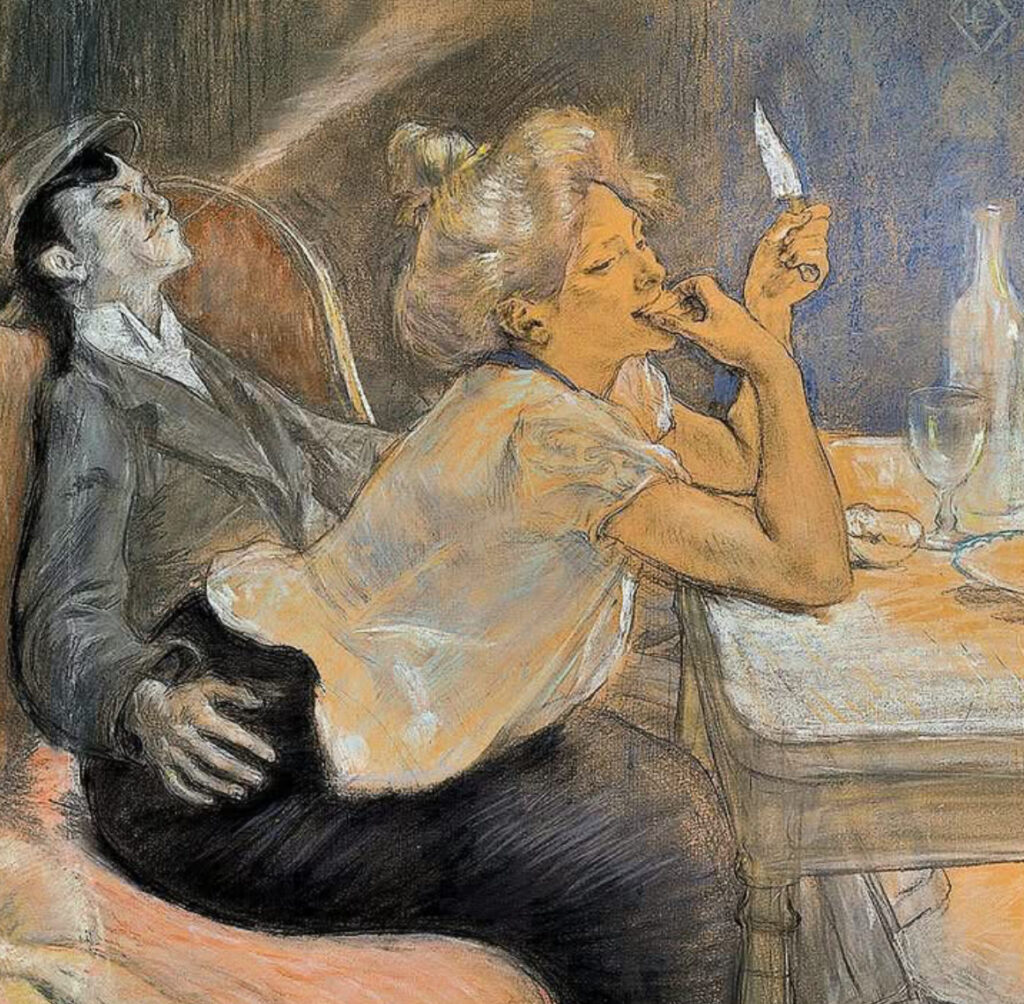“Souper de l’Apache” (1901) by Louis Legrand stands as a compelling artistic depiction of Parisian nightlife, offering an intimate glimpse into the world of the Apaches—the term used to describe members of the Parisian underworld in the early 20th century.
Created using charcoal and pastel on paper, this artwork, measuring 74 x 109 cm, is currently housed in The Pushkin State Museum of Fine Arts in Moscow. Legrand, known for his keen observational skills and ability to convey human expression with depth and realism, captures a scene of camaraderie, mystery, and raw social energy.
Through this masterpiece, Legrand brings to life a subculture often shrouded in secrecy and fear, yet full of character and emotional complexity. His work reflects an era when Paris was undergoing social transformation, and his art serves as both a documentation and an artistic interpretation of this time.
Louis Legrand: The Artist and His Vision
Louis Legrand (1863–1951) was a French artist and illustrator, best known for his prints, drawings, and paintings that captured the social landscapes of Paris. His works often depicted themes of urban life, nightlife, and marginalized communities, showing both their harsh realities and their beauty.
Legrand studied under Félix Buhot, a well-known printmaker, and later developed his own signature style that blended symbolism, impressionism, and realism. His art was influenced by Henri de Toulouse-Lautrec, particularly in how he depicted cabaret dancers, working-class figures, and Parisian underworld characters.
Legrand’s works often served as a social commentary, reflecting the undercurrents of social hierarchy, class struggle, and urban transformation. He did not merely document scenes; he infused them with an emotional resonance that allowed viewers to connect with the subjects.
The Apache Subculture and Its Role in Legrand’s Work
The Apaches were not a Native American group but rather a term used in France to describe the criminal elements of Paris, including gang members, street fighters, and other underworld figures. These individuals were known for their distinctive dress, secret codes, and a reputation for violence, but they also represented a unique counterculture within the city’s vibrant nightlife.
Legrand, like many artists of his time, was fascinated by these figures, not merely as criminals but as human beings with their own stories, struggles, and forms of expression. His works, including Souper de l’Apache, depict them in moments of everyday life, where they are seen laughing, drinking, eating, and socializing, rather than solely engaging in criminal acts.
This approach challenges societal stereotypes by presenting the Apaches in a more nuanced and relatable manner—as people with emotions, relationships, and a sense of community.
A Closer Look at “Souper de l’Apache”
Legrand’s masterful use of charcoal and pastel creates an atmosphere that feels both intimate and dramatic. The scene is dimly lit, with light and shadow playing a crucial role in shaping the mood.
• The central focus of the painting is a table, around which a group of Apaches is gathered, enjoying a meal and engaging in conversation.
• The gestures and facial expressions of the figures convey a sense of laughter, camaraderie, and intrigue.
• Legrand’s subtle shading and highlights add depth, creating a sense of movement and realism.
Through these techniques, Legrand not only captures physical appearances but also the emotional dynamics within the group. The viewer feels as if they are eavesdropping on a private moment, immersed in the setting.
Symbolism and Themes
Beyond its artistic qualities, Souper de l’Apache carries significant symbolic meaning.
Representation of Marginalized Groups
• The Apaches were often portrayed as dangerous outsiders, but Legrand humanizes them, presenting them as a tight-knit community rather than a mere criminal element.
The Contrast of Light and Darkness
• The use of chiaroscuro (strong contrasts between light and dark) enhances the mood, symbolizing the duality of life—moments of joy and moments of hardship.
Social Observation and Realism
• The clothing, body language, and interactions in the scene reflect the authenticity of working-class Parisian life, grounding the painting in historical and cultural reality.
Depicting the Hidden Side of Paris
At the turn of the 20th century, Paris was a city of contrasts—glamorous and sophisticated on one hand, yet filled with poverty, crime, and underground subcultures on the other. While many artists focused on the glamorous aspects of Parisian life, Legrand chose to shine a light on the lesser-seen narratives.
His work resonates with the tradition of social realism, similar to the works of Honoré Daumier and Gustave Courbet, who also sought to depict the true nature of everyday life rather than romanticized versions of it.
By showcasing the dynamics of the Apache community, Legrand provided a historical record of a subculture that has since faded into history but remains a part of Paris’s rich cultural tapestry.
Influence on Later Artists and Interpretations
Legrand’s ability to blend symbolism, realism, and impressionist techniques influenced many later artists who sought to document urban life and subcultures. His work also contributed to the mythology of the Apaches, who were later depicted in literature, theater, and film.
Why “Souper de l’Apache” Remains Relevant Today
More than a century after its creation, Souper de l’Apache continues to resonate with audiences because of its:
• Timeless exploration of human interaction
• Social commentary on class and marginalization
• Masterful artistic technique
It serves as a reminder that art is not just about aesthetics but also about storytelling, history, and human connection.
A Testament to Legrand’s Bequest
Louis Legrand’s Souper de l’Apache stands as a powerful artistic and historical document, capturing the essence of Parisian underground life in the early 20th century.
Through his keen observational skills, technical brilliance, and deep empathy for his subjects, Legrand presents a scene that is both visually captivating and rich in social commentary.
Housed in The Pushkin State Museum of Fine Arts, this masterpiece continues to inspire art lovers, historians, and anyone fascinated by the hidden stories of the past.
It is a testament to the power of art in preserving history, challenging perceptions, and celebrating the complexities of human society.
No comments yet.








